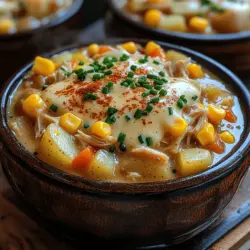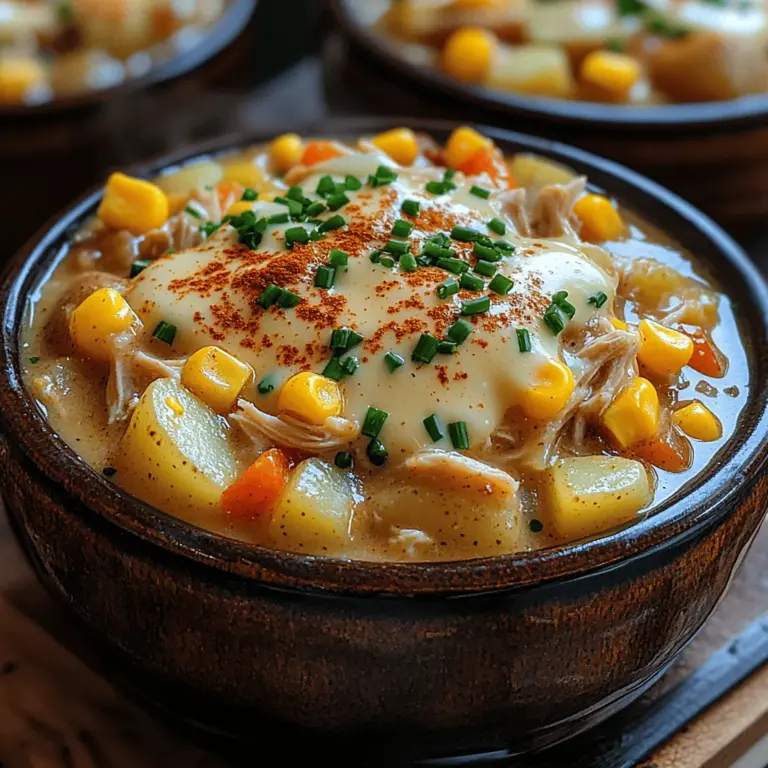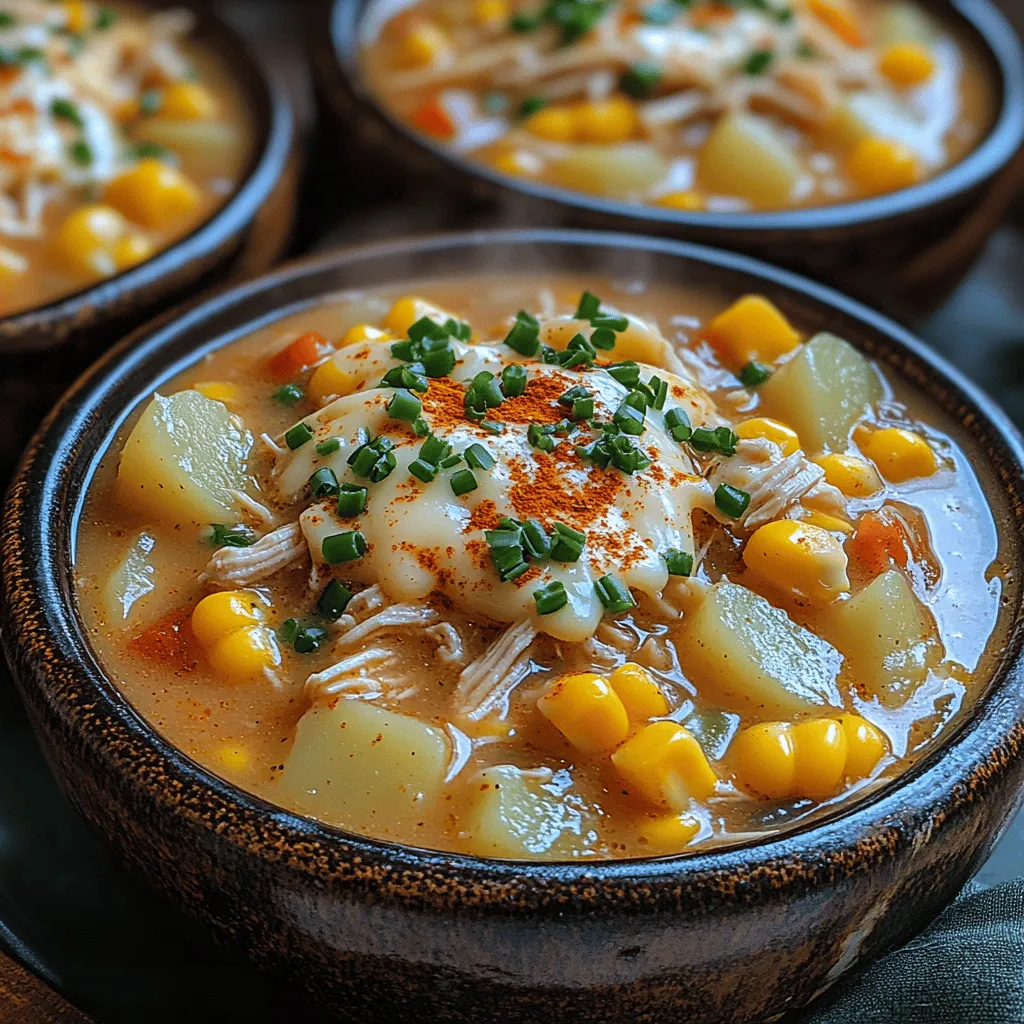Introduction
When the weather turns chilly or you’re simply in need of a comforting meal, few dishes can rival the warm embrace of a hearty chowder. This category of soup is not just a meal; it’s an experience, often filled with rich flavors and creamy textures that satisfy both the body and soul. Among the many variations of chowder, Chicken Corn Chowder stands out as a favorite, combining the savory notes of chicken with the sweet crunch of corn, all enveloped in a velvety broth.
Chicken Corn Chowder is the perfect dish to whip up any time of the year, whether you’re warming up on a cold winter evening or cooling down with a light meal in the summer. Its versatility allows for a wide array of ingredient substitutions, accommodating various dietary preferences and restrictions. Best of all, using a slow cooker makes this recipe incredibly convenient. You can set it up in the morning and return home to a delicious, aromatic meal that’s ready to serve.
In this article, we will delve into the details of crafting this cozy chowder, exploring its ingredients, preparation steps, and the magic of slow cooking. Get ready to embrace the warmth and heartiness of Chicken Corn Chowder, a dish that promises to be a staple in your kitchen.
Understanding the Ingredients
Before diving into the preparation of your Cozy Slow-Cooker Chicken Corn Chowder, it’s essential to understand the role of each ingredient in creating this delightful dish. The following components not only contribute to the flavor but also enhance the overall nutritional profile of the chowder.
Chicken: Source of Protein and Flavor
The star ingredient in any chicken chowder is, of course, chicken. Using boneless, skinless chicken breasts or thighs provides a lean source of protein that keeps the dish filling and satisfying. The chicken absorbs the flavors of the broth and spices, becoming tender and flavorful during the slow cooking process. Thighs, in particular, tend to be juicier and add an extra layer of richness to the chowder.
Corn: Adds Sweetness and Texture
Corn is another key player in this recipe, providing natural sweetness and a delightful crunch. Fresh corn, if in season, brings a bright flavor that frozen or canned corn may lack, but any form will work in a pinch. Corn not only adds texture but also contains essential vitamins and minerals, including fiber, vitamin C, and folate, making it a nutritious addition to your chowder.
Vegetables: Nutritional Benefits and Flavor Profile
To create a well-rounded chowder, we’ll include a variety of vegetables. Common choices include onions, bell peppers, and potatoes. Onions and bell peppers add aromatic depth and flavor, while potatoes contribute heartiness and help thicken the chowder as they cook down. These vegetables are not only flavorful but also packed with essential nutrients, making your chowder both delicious and healthful.
Spices: Enhancing the Overall Taste
The right blend of spices can elevate your Chicken Corn Chowder from good to unforgettable. Basic seasonings like salt and pepper are essential, but don’t hesitate to experiment with additional spices such as garlic powder, thyme, or smoked paprika. Each of these adds a unique twist to the chowder’s flavor profile, enhancing the overall taste without overpowering the primary ingredients.
Cream and Cheese: Contributing to the Chowder’s Creaminess
To achieve that luxurious, creamy texture that chowder is known for, we will incorporate both cream and cheese. Heavy cream adds richness and a velvety mouthfeel, while shredded cheese—such as cheddar or Monterey Jack—melts into the broth, creating a thick consistency and adding a savory note. If you’re looking for a lighter version, consider substituting half-and-half or using a dairy-free alternative to achieve creaminess without the calories.
Preparing the Cozy Slow-Cooker Chicken Corn Chowder
Now that we have a good understanding of the ingredients, let’s dive into the preparation process of this cozy Chicken Corn Chowder. This section will guide you through the initial steps to ensure your chowder turns out delicious every time.
Preparing the Chicken: Importance of Seasoning and Searing
1. Choose Your Chicken: Begin with 1 to 1.5 pounds of boneless, skinless chicken breasts or thighs. The choice between breasts or thighs depends on your preference; thighs will yield a more flavorful chowder, while breasts are leaner.
2. Seasoning: Generously season the chicken with salt and pepper. This step is crucial as it enhances the chicken’s natural flavors and ensures that every bite is well-seasoned.
3. Searing (Optional but Recommended): If time allows, searing the chicken in a skillet over medium heat for a few minutes on each side can add a beautiful golden color and deepen the flavor. This step is optional but highly recommended for those who want an extra layer of taste. Once seared, transfer the chicken to the slow cooker.
Layering the Vegetables: Techniques to Ensure Even Cooking
1. Chop Your Vegetables: While the chicken is cooking, chop your vegetables. Dice one medium onion, chop one bell pepper (any color works), and peel and cube two medium potatoes. You can also add carrots or celery if you desire more vegetables.
2. Layering: Place the chopped vegetables over the chicken in the slow cooker. Layering is essential for even cooking; the chicken should be at the bottom to absorb the flavors from the ingredients above it.
3. Corn Addition: If you’re using fresh corn, now is the time to cut the kernels off the cob. If using canned or frozen corn, you can add it directly to the slow cooker at this stage.
Combining Ingredients: Best Practices for Layering in a Slow Cooker
1. Spice It Up: Sprinkle your chosen spices over the layered chicken and vegetables. A teaspoon of garlic powder, a teaspoon of dried thyme, and a pinch of smoked paprika can add wonderful depth to the chowder.
2. Liquid Base: Pour in about 4 cups of low-sodium chicken broth. This will be the base of your chowder, infusing all the ingredients with flavor as they cook.
3. Creamy Finish: If using heavy cream, hold off on adding it until the very end of the cooking process. This keeps the cream from curdling and ensures a smooth, creamy texture.
Slow Cooking Process: Explanation of Time Settings and Their Effects on Flavor and Texture
1. Setting Your Slow Cooker: Cover the slow cooker and set it on low for 6-8 hours or on high for 3-4 hours. The longer cooking time on low allows for the flavors to meld beautifully and the chicken to become tender and easy to shred.
2. Checking for Doneness: About 30 minutes before serving, check the chicken for doneness. It should reach an internal temperature of 165°F. If the chicken is cooked, remove it from the pot and shred it using two forks. Return the shredded chicken to the slow cooker.
3. Final Touches: Stir in the heavy cream (if using) and shredded cheese, allowing them to melt into the chowder. Taste and adjust the seasoning, adding more salt and pepper if needed.
By following these detailed steps, you’ll create a delightful Cozy Slow-Cooker Chicken Corn Chowder that’s not only easy to prepare but also a dish that will warm hearts and tummies alike. Stay tuned for the next section, where we’ll explore the cooking process in-depth, discussing the benefits of slow cooking and how it enhances the flavors and textures of this comforting meal.
Tips on Monitoring Cooking Time and Temperature Settings
When making Cozy Slow-Cooker Chicken Corn Chowder, careful attention to cooking time and temperature settings is essential for achieving the perfect texture and flavor. Slow cookers are designed to cook food gently over a long period, which is ideal for tenderizing meat and enhancing the flavors of the ingredients. Here are some tips for monitoring your cooking process:
1. Use the Right Setting: Most slow cookers have low and high settings. For chowder, the low setting is preferred, as it allows the flavors to meld together beautifully over several hours. If you’re short on time, you can use the high setting but be sure to monitor the cooking closely.
2. Timing is Key: Generally, chicken corn chowder takes about 6-8 hours on low or 3-4 hours on high. If you’re using frozen chicken, it may extend the cooking time slightly, so keep an eye on it.
3. Check for Doneness: The chicken should reach an internal temperature of 165°F (75°C). Use a meat thermometer to ensure it is cooked through. If you prefer a more shredded consistency, you can cook it longer without worry, as the chicken will become very tender.
4. Avoid Lifting the Lid: Each time you lift the lid, heat escapes, which can lengthen the cooking time. Try to resist the temptation to peek until the end of the cooking cycle.
5. Adjusting Consistency: If the chowder is too thick at the end of cooking, you can thin it out with a bit of chicken broth or water. Conversely, if it’s too thin, let it cook uncovered for the last 30 minutes to allow some liquid to evaporate.
Importance of Shredding the Chicken and Returning It to the Chowder
Shredding the chicken is a crucial step in completing your chowder. After the cooking time is up, carefully remove the chicken breasts from the slow cooker. Using two forks, shred the chicken into bite-sized pieces. This not only enhances the texture of the chowder, making it heartier and more cohesive, but it also ensures that every spoonful is packed with flavor.
Once shredded, return the chicken to the slow cooker along with any accumulated juices. This helps to keep the chowder moist and rich. Stir the mixture well to evenly distribute the chicken throughout the chowder, ensuring each bowl is filled with tender chicken and delicious corn.
Final Steps: Incorporating Cream and Cheese for a Luxurious Finish
To elevate your cozy chicken corn chowder, the final steps involve adding cream and cheese. The combination of these ingredients adds richness and a velvety texture that makes each spoonful feel indulgent.
1. Add Cream: About 30 minutes before serving, stir in heavy cream or half-and-half. This will enhance the chowder’s creaminess and balance the flavors. If you’re looking for a lighter option, you can substitute with coconut cream for a dairy-free version.
2. Incorporate Cheese: For an extra layer of flavor, add shredded cheddar cheese to the slow cooker. Stir until melted and fully combined. This will not only make the chowder creamy but also add a delightful cheesy flavor that complements the sweetness of the corn.
3. Taste and Adjust: After adding these final ingredients, taste the chowder and adjust the seasoning if necessary. You might want to add a pinch of salt, pepper, or even a dash of hot sauce for those who enjoy a bit of heat.
Serving Suggestions
When it comes to serving your Cozy Slow-Cooker Chicken Corn Chowder, presentation plays an important role in enhancing the overall dining experience. Here are some ideas:
1. Presentation Ideas: Serve the chowder in rustic bowls or ramekins to emphasize its comforting nature. A sprinkle of fresh herbs, such as chives or parsley, can add a pop of color on top.
2. Suggested Pairings: This chowder pairs beautifully with crusty bread, such as sourdough or baguette, which can be used for dipping. A simple side salad with a light vinaigrette can balance the richness of the chowder and add refreshing crunch.
3. Garnishes: Consider garnishing your chowder with additional shredded cheese, a dollop of sour cream, or a sprinkle of smoked paprika for an extra flavor boost. Fresh cilantro or green onions can also enhance both the visual appeal and taste of the dish.
Nutritional Benefits
The ingredients in Cozy Slow-Cooker Chicken Corn Chowder not only deliver a delicious meal but also pack a nutritional punch. Here’s a breakdown of some key health benefits:
1. Protein from Chicken: Chicken is an excellent source of lean protein, which is vital for muscle repair and growth. A serving of chicken corn chowder will help you feel satiated and energized.
2. Vitamins and Minerals from Vegetables: The corn, potatoes, and other vegetables contribute essential vitamins and minerals. Corn provides fiber and antioxidants, while potatoes offer potassium and Vitamin C.
3. Healthy Fats from Cream and Cheese Options: While cream and cheese add richness, they can also provide healthy fats, which are crucial for nutrient absorption. Opting for lower-fat dairy options can help reduce calorie intake without sacrificing flavor.
4. Dietary Modifications: For those with dietary restrictions, there are several ways to adapt this recipe. Use plant-based cream and cheese alternatives for a dairy-free version. You can also substitute chicken with tofu or chickpeas for a vegetarian option that still delivers protein.
Variations and Customizations
One of the great things about Cozy Slow-Cooker Chicken Corn Chowder is its adaptability. Here are some ideas for customizing the recipe to suit different tastes:
1. Alternative Proteins: If chicken isn’t your preference, you can use turkey or even plant-based proteins like tofu or tempeh for a vegetarian version. These alternatives will pair well with the chowder’s flavors.
2. Vegetable Substitutions: Depending on the season, feel free to swap in seasonal vegetables. Zucchini, bell peppers, or even diced carrots can add variety and nutrition.
3. Spice Level Adjustments: For those who enjoy a kick, consider adding diced jalapeños or a teaspoon of cayenne pepper to the chowder during cooking. Alternatively, for a milder version, stick to sweet paprika or skip the spices altogether.
Conclusion
Cozy Slow-Cooker Chicken Corn Chowder is the perfect dish for those chilly evenings when comfort food is a must. With its heartwarming flavors and creamy texture, it brings warmth to your kitchen and joy to your table. This recipe not only provides a nourishing meal but also invites creativity and customization, making it a staple in any home cook’s repertoire.
As you gather your ingredients and embark on this cooking journey, remember to enjoy the process. Cooking is about sharing love and creating memories with those you care about. Whether you’re serving it at a family gathering or enjoying a quiet night in, this chowder is sure to satisfy. Embrace the adaptability of this recipe, and let it evolve to suit your taste and dietary preferences. Happy cooking!


